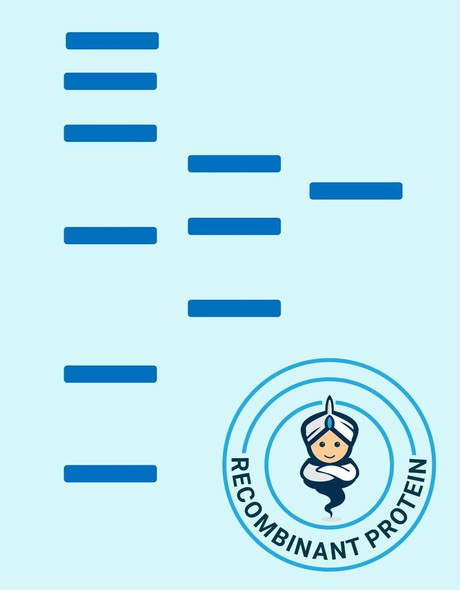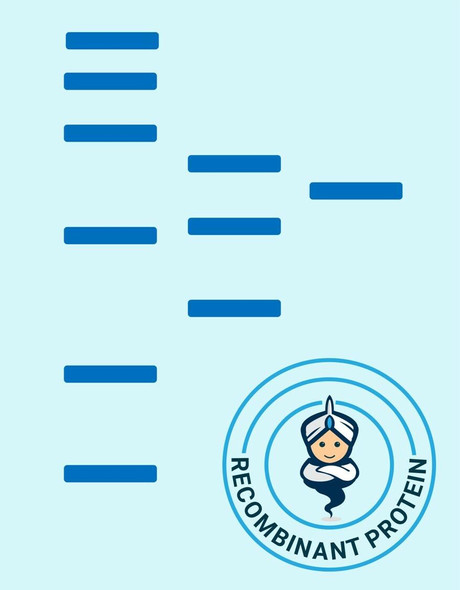Description
| Product Name: | Human FGF 21 Recombinant Protein |
| Product Code: | RPPB0241 |
| Size: | 25µg |
| Species: | Human |
| Target: | FGF 21 |
| Synonyms: | Fibroblast growth factor 21, FGF-21. |
| Source: | Escherichia Coli |
| Physical Appearance: | Sterile Filtered white lyophilized powder. |
| Formulation: | Lyophilized from PBS, pH 7.4. |
| Solubility: | It is recommended to reconstitute the lyophilized Fibroblast Growth Factor-21 Human Recombinant sterile 18M?-cm H2O not less than 100�g/ml, which can then be further diluted to other aqueous solutions. |
| Stability: | Lyophilized FGF-21 Human Recombinant although stable at room temperature for 3 weeks, should be stored desiccated below -18°C. Upon reconstitution Fibroblast Growth Factor 21 should be stored at 4°C between 2-7 days and for future use below -18°C.For long term storage it is recommended to add a carrier protein (0.1% HSA or BSA).Please prevent freeze-thaw cycles. |
| Purity: | Greater than 95.0% as determined by SDS-PAGE. |
| Amino Acid Sequence: | MHPIPDS SPLLQFGGQV RQRYLYTDDA QQTEAHLEIR EDGTVGGAAD QSPESLLQLK ALKPGVIQIL GVKTSRFLCQ RPDGALYGSL HFDPEACSFR ELLLEDGYNV YQSEAHGLPL HLPGNKSPHR DPAPRGPARF LPLPGLPPAP PEPPGILAPQ PPDVGSSDPL SMVGPSQGRS PSYAS |
| Biological Activity: | The ED50 as determined by the dose dependent stimulation of the proliferation of BAF3 cells expressing FGF receptors is 0.06-0.4�g/ml in the presence of betaKlotho. |
The FGFs are a family of more than 20 small (~17�26 kDa) secreted peptides. The initial characterization of these proteins focused on their ability to stimulate fibroblast proliferation. This mitogenic activity was mediated through FGF receptors (FGFRs) 1, 2, or 3. A fourth closely related tyrosine kinase receptor (FGFR4) was able to bind the FGFs but did not lead to a mitogenic response.FGFs modulate cellular activity via at least 5 distinct subfamilies of high-affinity FGF receptors (FGFRs): FGFR-1, -2, -3, and -4, all with intrinsic tyrosine kinase activity and, except for FGFR-4, multiple splice isoforms, and FGFR-5, which lacks an intracellular kinase domain. There is growing evidence that FGFRs can be important for regulation of glucose and lipid homeostasis. The overexpression of a dominant negative form of FGFR-1 in cells leads to diabetes in mice, which thus implies that proper FGF signaling is required for normal cell function and glycemia maintenance. FGFR-2 appears to be a key molecule during pancreatic development. Moreover, FGFR-4 has been implicated in cholesterol metabolism and bile acid synthesis.FGF-19, has been shown to cause resistance to diet-induced obesity and desensitization and to improve glucose and lipid profiles in diabetic rodents. Since these effects, at least in part, are mediated through the observed changes in metabolic rates, FGF-19 can be considered as a regulator of energy expenditure.FGF-21 is preferentially expressed in liver, but an exact knowledge of FGF-21 bioactivity and its mode of action have been lacking to date. FGF-21 is a potent activator of glucose uptake on adipocytes, protects animals from diet-induced obesity when overexpressed in transgenic mice, and lowers blood glucose and triglyceride levels when therapeutically administered to diabetic rodents.
Fibroblast Growth Factor -21 Human Recombinant produced in E.Coli is a single, non-glycosylated, polypeptide chain containing 182 amino acids and an N-terminal Methionin (bold), having a molecular weight of 19.5 kDa. The FGF-21 is purified by proprietary chromatographic techniques.
| UniProt Protein Function: | FGF21: Stimulates glucose uptake in differentiated adipocytes via the induction of glucose transporter SLC2A1/GLUT1 expression (but not SLC2A4/GLUT4 expression). Activity requires the presence of KLB. Belongs to the heparin-binding growth factors family. |
| UniProt Protein Details: | Protein type:Secreted, signal peptide; Secreted Chromosomal Location of Human Ortholog: 19q13.33 Cellular Component: extracellular region Molecular Function:protein binding; growth factor activity; fibroblast growth factor receptor binding Biological Process: positive regulation of glucose import; cell-cell signaling; positive regulation of cell proliferation; positive regulation of low-density lipoprotein receptor biosynthetic process; signal transduction |
| NCBI Summary: | The protein encoded by this gene is a member of the fibroblast growth factor (FGF) family. FGF family members possess broad mitogenic and cell survival activities and are involved in a variety of biological processes including embryonic development, cell growth, morphogenesis, tissue repair, tumor growth and invasion. The function of this growth factor has not yet been determined. [provided by RefSeq, Jul 2008] |
| UniProt Code: | Q9NSA1 |
| NCBI GenInfo Identifier: | 13626703 |
| NCBI Gene ID: | 26291 |
| NCBI Accession: | Q9NSA1.1 |
| UniProt Secondary Accession: | Q9NSA1,Q8N683, |
| UniProt Related Accession: | Q9NSA1 |
| Molecular Weight: | 22,300 Da |
| NCBI Full Name: | Fibroblast growth factor 21 |
| NCBI Synonym Full Names: | fibroblast growth factor 21 |
| NCBI Official Symbol: | FGF21�� |
| NCBI Protein Information: | fibroblast growth factor 21 |
| UniProt Protein Name: | Fibroblast growth factor 21 |
| Protein Family: | Fibroblast growth factor |
| UniProt Gene Name: | FGF21�� |
| UniProt Entry Name: | FGF21_HUMAN |










